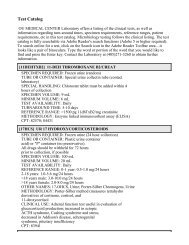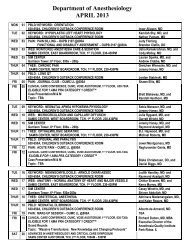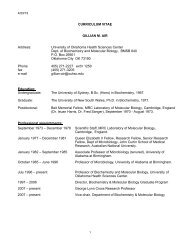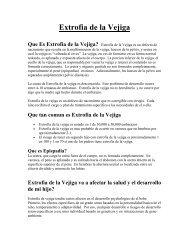THE DILATED URETER - OU Medicine
THE DILATED URETER - OU Medicine
THE DILATED URETER - OU Medicine
You also want an ePaper? Increase the reach of your titles
YUMPU automatically turns print PDFs into web optimized ePapers that Google loves.
WHAT EVERY UROLOGIST SH<strong>OU</strong>LD KNOW<br />
The most important aspect in the management of the dilated ureter in adults and<br />
children is identification of patients who will need and benefit from surgical repair.<br />
presence of other anomalies, such as contralateral ureteropelvic<br />
junction (UPJ) obstruction, renal agenesis or ectopia, and<br />
ureteral duplication associated with primary obstructed megaureters,<br />
may be seen in up to 40% of affected patients. 5<br />
In adults, primary obstructed megaureter is usually detected<br />
when patients present with pain or other symptoms from urinary<br />
tract infection (UTI), calculi, or decreased renal function. 2<br />
In mild cases, however, patients are typically asymptomatic, and<br />
the condition is found during an unrelated workup.<br />
In the pediatric population, routine perinatal US has dramatically<br />
increased the likelihood of detection of the dilated<br />
ureter. 6 The megaureter can be dilated up to 3 cm and thus is<br />
easily identified on US as a hypoechoic cystic-appearing mass in<br />
the retroperitoneum that may extend from the UPJ to the<br />
ureterovesical junction (UVJ). 7 In a 5-year series in which US<br />
was performed on 3,856 fetuses after 28 weeks of gestation, the<br />
prevalence of primary megaureter at the level of the UVJ was<br />
approximately 1 in 2,000. 8<br />
GRADING<br />
Several different grading systems have been promulgated, but<br />
none is useful in predicting which patients will require surgery<br />
and which will benefit from observation. The earliest classification<br />
system, devised in 1978 by Pfister and Hendren, categorizes<br />
Embryology<br />
T<br />
he development of the ureter begins around the fifth<br />
week of gestation. A diverticulum arises from the<br />
posteriomedial aspect of the lower portion of the bilateral<br />
mesonephric ducts. It then elongates posteriorly to meet the<br />
metanephric blastema, thus inducing nephrogenesis. The tip<br />
of the ureteric bud dilates to form the collecting system from<br />
the ureterovesical junction (UVJ ) to the level of the<br />
collecting duct. During the sixth through the ninth weeks,<br />
the embryonic kidney ascends from its pelvic position.<br />
During the ascent of the kidneys, the ureters elongate.<br />
The lumen of the forming ureter develops from the<br />
midureter cranially and caudally until the eighth week.<br />
The urogenital sinus remains separated from the ureteric<br />
UROlogic<br />
➤ Primary obstructed megaureter is<br />
caused by an intrinsic abnormality<br />
or an adynamic segment of the<br />
distal ureter that leads to a<br />
functional obstruction.<br />
➤ While adults typically present with<br />
hematuria or symptomatic<br />
complaints from UTI or stone<br />
disease, most cases in children are<br />
detected antenatally.<br />
lumen by a membrane. This membrane, known as the<br />
Chwalle’s membrane, disappears by the middle of<br />
the eighth week. At approximately the ninth week of<br />
gestation, muscularization is induced by the passing of<br />
the first excreted urine. At 18 weeks, normal physiologic<br />
narrowing can be discerned at the ureteropelvic junction<br />
(UPJ) and the UVJ. It is at this time that dilation of the<br />
ureter may be observed. After 19 weeks, the ureter<br />
continues to grow; however, the normal ureteral<br />
diameter in the fetal population rarely exceeds 5 mm. 1<br />
REFERENCE<br />
1. Cussen LJ. The morphology of congenital dilatation of the ureter: intrinsic lesions.<br />
Aust NZ J Surg. 1971;441:185-194.<br />
JUNE 2006 CONTEMPORARY UROLOGY 45

















